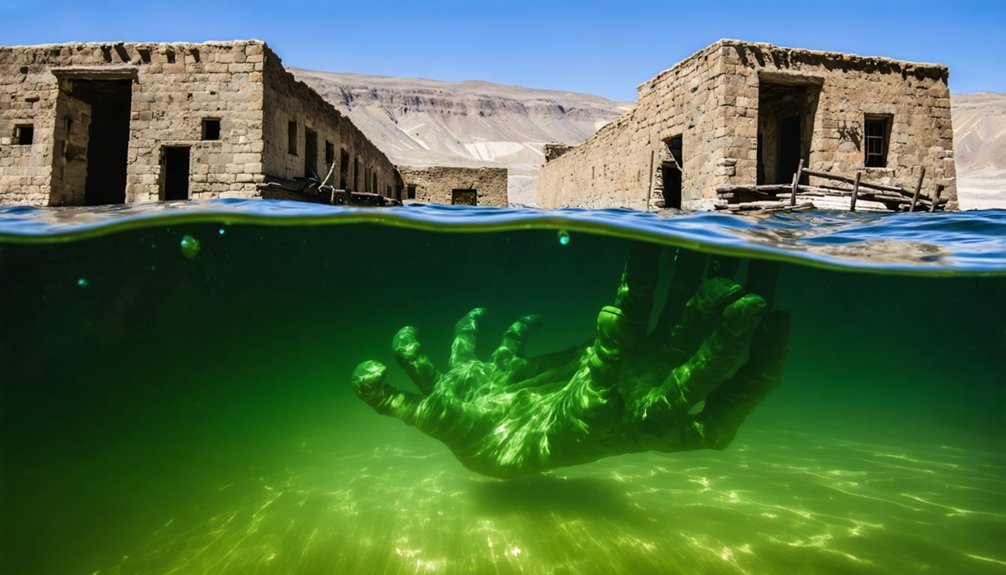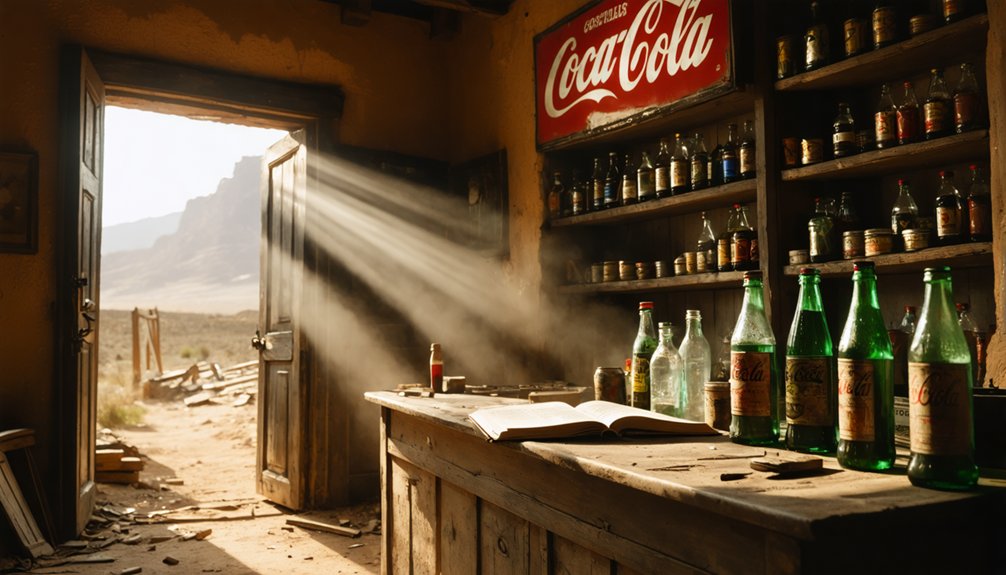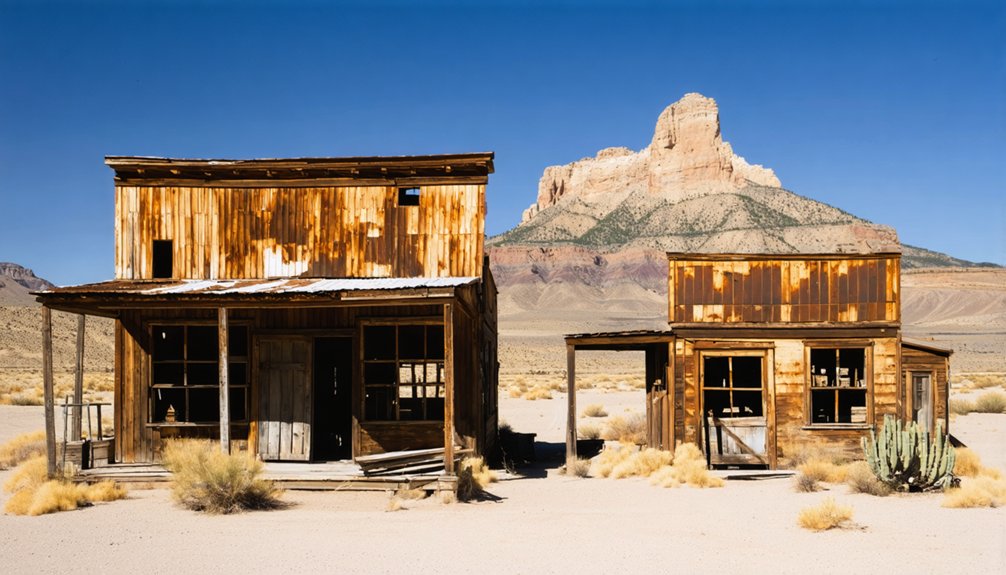Castle Dome Landing was an 1864 river port established 20 miles north of Yuma, Arizona, serving the silver mining district discovered a year earlier. You’ll find its original site submerged beneath Martinez Lake following Imperial Dam construction. The settlement once thrived with up to 3,000 people during peak periods, featuring stores, warehouses, and saloons. Today, the Castle Dome Museum preserves this legacy with over 60 restored buildings and authentic mining artifacts. The underwater ghost town holds more secrets.
Key Takeaways
- Castle Dome Landing was established in 1864 as a riverport supporting silver mining operations 20 miles north of Yuma.
- The original town now lies submerged beneath Martinez Lake following the Imperial Dam construction.
- At its peak, Castle Dome Landing had up to 3,000 residents with mercantiles, warehouses, schools, and churches.
- Mining operations continued from 1864 to 1979, yielding 200,000 ounces of silver from approximately 5,000 tons of ore.
- Today, Castle Dome Museum preserves the town’s history with over 60 restored buildings and thousands of authentic mining artifacts.
The Birth of a Desert River Port (1863-1864)
In 1863, the discovery of silver galena deposits in Arizona’s rugged desert mountains catalyzed the rapid establishment of the Castle Dome Mining District, setting in motion events that would transform a desolate stretch of Colorado River shoreline into an essential commercial hub.
As Jacob Snively’s Castle Dome Mining Company consolidated claims, the need for reliable logistics became apparent.
You’d have witnessed the strategic creation of Castle Dome Landing by 1864, positioned at a natural river bend about 20 miles north of Yuma. This location enabled river transportation of ore from mines 15-17 miles east.
The early mining settlement emerged rapidly—brush houses, adobe structures under construction, and canvas tents dotting the landscape as steamboats began docking at this significant new desert port. Captain Lorenzo Blackmar’s skilled navigation of the Colorado River aboard his vessel, the Mohave, proved vital to the settlement’s early development.
The initial description of the settlement in 1864 accurately captured the primitive frontier conditions of the budding mining community.
Life Along the Colorado: Castle Dome’s Heyday
During its peak between the 1870s and 1880s, Castle Dome Landing thrived as the Colorado River’s essential commercial artery, where steamboats regularly docked at the river’s natural bend to transport ore, supplies, and passengers between the mining district and Yuma.
You’d have found a surprisingly diverse frontier society, with population estimates ranging from 50 permanent residents to 3,000 during busy periods, complete with mercantile stores, warehouses, schools, and churches serving families and miners alike.
The landing’s saloons and hotels buzzed with Wild West entertainment, particularly during the annual Mexican Independence Day celebrations that drew visitors from Yuma seeking revelry and business opportunities in this desert river port.
Today, visitors can no longer see this once-bustling frontier outpost since the area was completely submerged underwater following the construction of Imperial Dam.
River Trade Hub
Situated strategically along a natural bend in the Colorado River, Castle Dome Landing emerged around 1864 as an essential port that would transform the economic landscape of the Arizona Territory.
When you visited this bustling hub in its 1870s-1880s prime, you’d find a commercial center rivaling Yuma, with approximately 3,000 residents engaged in river commerce.
The landing served as the first northbound steamboat stop from Yuma, establishing crucial trade routes between mining operations and distant markets.
Steamboats navigated seasonal challenges—summer’s low water levels and monsoon’s powerful currents—to transport silver, lead, and other minerals downstream toward San Francisco. The area was a vital shipping point for ore from the nearby mines to support the growing western economy.
This river navigation system created a lifeline for the Castle Dome mining district located about 15-17 miles east, fueling regional prosperity until railroads eventually diminished its significance.
Desert Frontier Society
Life along the Colorado River transformed Castle Dome Landing from a simple river stop into a vibrant desert frontier community during its 1870s-1880s heyday.
As population swelled to 3,000 residents, you’d find a remarkably diverse society where American settlers, European immigrants, and the influence of earlier Native American inhabitants created unique opportunities for cultural exchange.
Daily life demanded ingenious resource management in this harsh desert environment.
With the Colorado River lying 20 miles away, water acquisition became a community-wide challenge.
You’d witness a complete frontier infrastructure develop—schools, churches, saloons and essential services—all established by determined residents adapting to isolation and scarcity.
The museum showcases the town’s development with over 60 buildings salvaged and restored to authenticity.
The community’s permanence is evidenced in its cemetery, reflecting multi-generational commitment despite the boom-and-bust cycles that eventually led to the town’s decline as mining fortunes waned.
Mining operations focused on extracting valuable gold, silver, lead, and zinc deposits until activities finally ceased in the 1970s.
Wild West Entertainment
Five distinctive saloons formed the pulsating heart of Castle Dome Landing‘s entertainment scene, where miners, travelers, and locals gathered to escape the grueling demands of frontier life.
You’d find poker and faro tables surrounded by hopeful gamblers, their fortunes rising and falling with each dealt hand. The saloons culture extended beyond drinking—these establishments served as community hubs where news spread and business deals were struck. Today’s visitors can explore these historical spaces among the over 50 buildings meticulously restored at the museum site.
When you weren’t testing your luck at gambling games, you might enjoy live fiddle or piano music that transformed the wooden floors into impromptu dance halls. The establishment of the Fort Yuma military presence in 1852 brought soldiers who frequently visited these entertainment venues during leave.
For special occasions, you’d join your neighbors at community dances or Fourth of July celebrations. During the town’s peak years, traveling shows and circuses offered rare glimpses of entertainment from the outside world.
Mining Riches: The Economic Engine Behind the Settlement
The discovery of mineral wealth in the Castle Dome region catalyzed one of Arizona’s most enduring mining enterprises, spanning from Spanish exploration in the 1600s to the district’s final closure in 1979.
As you explore this historic district, you’ll find evidence of over 300 mines that once fueled a bustling economy across 10 square miles.
The district’s economic significance hinged on four essential elements:
- Silver-rich galena ore as the primary target, though mining innovations struggled with separation challenges.
- Strategic importance of lead production during both World Wars.
- Economic fluctuations tied directly to silver market prices and labor struggles.
- Transportation infrastructure centered on Castle Dome Landing, which served as a critical shipping port connecting to California smelters.
By 1878, miners had extracted an impressive 200,000 ounces of silver from approximately 5,000 tons of ore, demonstrating the area’s remarkable productivity.
Castle Dome was once the home to a thriving community of 3,000 residents during its peak in the early 20th century, making it larger than nearby Yuma at that time.
Daily Life and Social Structure in a Frontier Town

Amid the desolate beauty of the Sonoran Desert, Castle Dome Landing evolved from a mere mining outpost into a thriving frontier community where nearly 3,000 residents carved out an existence by the 1880s.
Your daily routines would have revolved around mining’s harsh realities—grueling shifts extracting silver under dangerous conditions. Social hierarchies emerged naturally, with mine owners and merchants standing above laborers and claim squatters.
You’d find respite in one of five saloons, where whiskey flowed freely and brawls erupted regularly. Despite the rough atmosphere, families established roots, creating institutions like churches and schools.
The frontier settlement operated under informal but strict governance, with disputes often resolved through gunfire or sheriff intervention. While miners comprised the workforce backbone, you might also find employment in transportation, mercantile operations, or other essential services supporting this isolated desert community.
The Slow Decline: When the Silver Ran Dry
As Castle Dome’s silver production declined and processing costs exceeded profits, a devastating economic ripple effect transformed the once-bustling mining district.
You’d have witnessed businesses shuttering, essential services disappearing, and property values plummeting as mining companies withdrew their financial backing throughout the mid-20th century.
The community experienced a mass exodus after the school closed in 1950, with families relocating to find employment elsewhere, leaving behind empty buildings that would eventually constitute the ghost town you can visit today.
Economic Ripple Effects
While Castle Dome’s silver mines operated continuously for an impressive 115 years from 1864 to 1979, their gradual decline triggered far-reaching economic consequences throughout the region.
The economic transformation wasn’t sudden but accelerated as silver extraction costs exceeded market value and ore quality diminished beyond 700 feet.
You’ll find the community resilience tested through four distinct phases:
- Capital flight – Investment from New York and San Francisco dried up as returns diminished
- Service collapse – Schools closed by 1950, followed by mercantiles, hotels, and professional services
- Population exodus – The once-thriving 3,000-person community dispersed as wages disappeared
- Supply chain disruption – Regional transportation hubs and equipment suppliers lost their primary customers
What you’re witnessing in Castle Dome’s remains today represents the final stage of an economic ecosystem that couldn’t adapt when its foundational industry failed.
Community Mass Exodus
The slow decline of Castle Dome began when silver ore yields started diminishing in the late 19th century, initiating what would become a decades-long community exodus.
You’d have witnessed the once-thriving population of 3,000 gradually disappear as mining operations became less profitable and eventually unsustainable.
As rich veins of silver, lead, and copper depleted, mining closures triggered dramatic population shifts.
Without employment opportunities, families abandoned their homes, businesses shuttered, and essential services vanished.
The harsh desert environment, with water sources 20 miles away, only accelerated this departure.
Underwater Ghost Town: The Imperial Dam’s Impact

Beneath the placid waters of Martinez Lake, created by the Imperial Dam reservoir approximately 30 miles north of Yuma, Arizona, lies the original Castle Dome Landing—a once-thriving mining community now transformed into an underwater ghost town.
The submerged settlement at coordinates 32°57′54″N 114°27′49″W presents unique challenges for underwater archaeology and historical preservation:
- The original landing site became completely submerged when Imperial Dam’s construction flooded the area, forcing abandonment.
- Water and sediment have preserved yet rendered inaccessible the town’s physical remnants.
- Mining operations continued nearby on dry land until the 1970s despite the original site’s submersion.
- Today’s Castle Dome Museum exists as a separate reconstruction on dry land, preserving the legacy of what’s now hidden beneath the reservoir.
Haunted History: The Lady in White and Other Tales
Legends of spectral residents have become deeply intertwined with Castle Dome’s identity as a ghost town, with the mysterious Lady in White standing as the settlement’s most renowned supernatural figure.
You’ll find her ghostly sightings centered around Hotel La More, where miners once lodged before meeting their fates in the perilous mines.
The town’s violent history fuels these spectral tales. Four miners perished in an 1887 flood, trapped 450 feet underground, while others met their ends through beheadings, knife wounds, and shootouts.
Beyond the white-haired apparition, visitors report unexplained noises, cold spots, and unseen touches throughout the property.
Mining dangers that claimed so many lives form the foundation of Castle Dome’s haunted reputation, with over 300 nearby mines serving as grim reminders of frontier mortality.
Resurrection Through Preservation: The Castle Dome Museum

While ghostly legends draw many visitors to Castle Dome Landing, the physical resurrection of this once-abandoned mining settlement represents an equally compelling story.
In 1993, Allen and Stephanie Armstrong purchased the land just as the U.S. Fish & Wildlife Service planned to clear all mining remains. Their preservation efforts saved this slice of Arizona’s silver mining heritage from oblivion.
Today, you’ll experience authentic mining history through:
Step back in time and immerse yourself in the preserved legacy of Arizona’s silver mining past.
- Over 20 meticulously restored original buildings including saloons, a jail, and a blacksmith shop
- Thousands of genuine mining artifacts salvaged from the abandoned town and surrounding mines
- A functional 1890s steam stamp mill that demonstrates actual mining operations
- Self-guided tours through both the ghost town and historic mining district, powered entirely by solar energy
Visiting Today: What Remains of Arizona’s Mining Legacy
Standing as a tribute to Arizona’s once-thriving mining industry, Castle Dome Landing today offers visitors a rare glimpse into the state’s silver-rich past through its collection of over 50 meticulously restored structures.
As you explore this open-air museum, you’ll walk among authentic buildings—seven original to the town—including the schoolhouse, barbershop, and hotel where “The Lady in White” ghost allegedly roams.
The ghost town preservation efforts have salvaged thousands of mining artifacts displayed throughout stone cabins and shops.
You’ll notice visible mine shafts, including the notorious 450-foot shaft where four miners perished in 1887.
Paths wind past tailings, abandoned machinery, and the historic cemetery—silent testimonies to the 3,000 souls who once called this boomtown home before it succumbed to the inevitable bust cycle of frontier mining communities.
Frequently Asked Questions
What Indigenous Tribes Occupied the Area Before Castle Dome’s Establishment?
You’ll discover the Quechan (Yuma) tribe primarily inhabited this Mojave Desert region, with other Yuman-speaking Native tribes living nearby before settlers displaced them during the 1850s military expansion period.
How Did Residents Survive Extreme Desert Temperatures Before Modern Cooling?
You’d survive by utilizing desert adaptations like adobe buildings with high ceilings and small windows, while employing cooling techniques such as evaporative methods, dawn/dusk activities, and community resource sharing.
Did Any Famous Outlaws or Gunfighters Visit Castle Dome Landing?
No, you won’t find evidence of famous outlaws or gunfighter encounters at Castle Dome Landing. Despite local tales of frontier violence, historical records don’t confirm visits by nationally recognized outlaws.
What Happened to Families and Descendants After the Town’s Abandonment?
Like dust in the desert wind, families scattered after abandonment. You’ll find their descendants preserving family legacies through museums, reunions, and oral histories while pursuing new lives in Yuma and beyond.
How Did Mail Service and Communication Work in Isolated Castle Dome?
You’d receive mail via steamboat and stagecoach routes until 1876, then through the Dome post office until 1904. Communication challenges included seasonal river fluctuations and the town’s isolation from major networks.
References
- https://whichmuseum.com/museum/castle-dome-mine-museum-yuma-10772
- https://www.arizonan.com/ghost-towns/castle-dome-landing/
- https://www.islands.com/1897773/longest-working-mining-town-arizona-abandoned-mountain-ghost-castle-dome-landing/
- https://kids.kiddle.co/Castle_Dome_Landing
- http://www.castledomemuseum.org/Castle-Dome-City.html
- https://www.youtube.com/watch?v=poSUm1oMz08
- https://www.wheelingit.us/2015/02/20/the-living-ghost-town-castle-dome-city-museum-kofa-az/
- https://www.visityuma.com/things-to-do/museums/castle-dome/
- https://azoffroad.net/castle-dome-city
- https://sweetamericanasweethearts.blogspot.com/2017/11/castle-dome-city-by-zina-abbott.html



